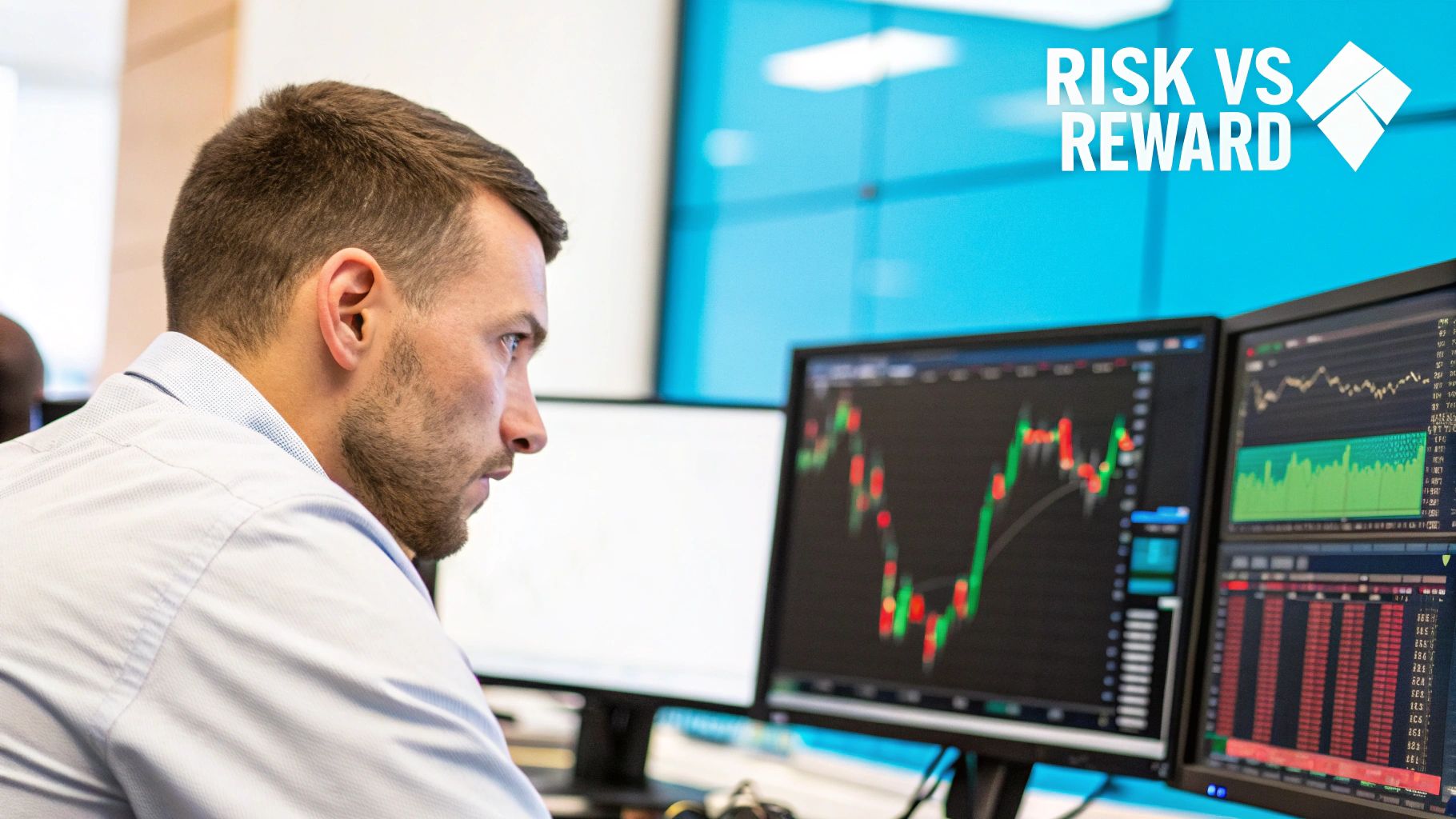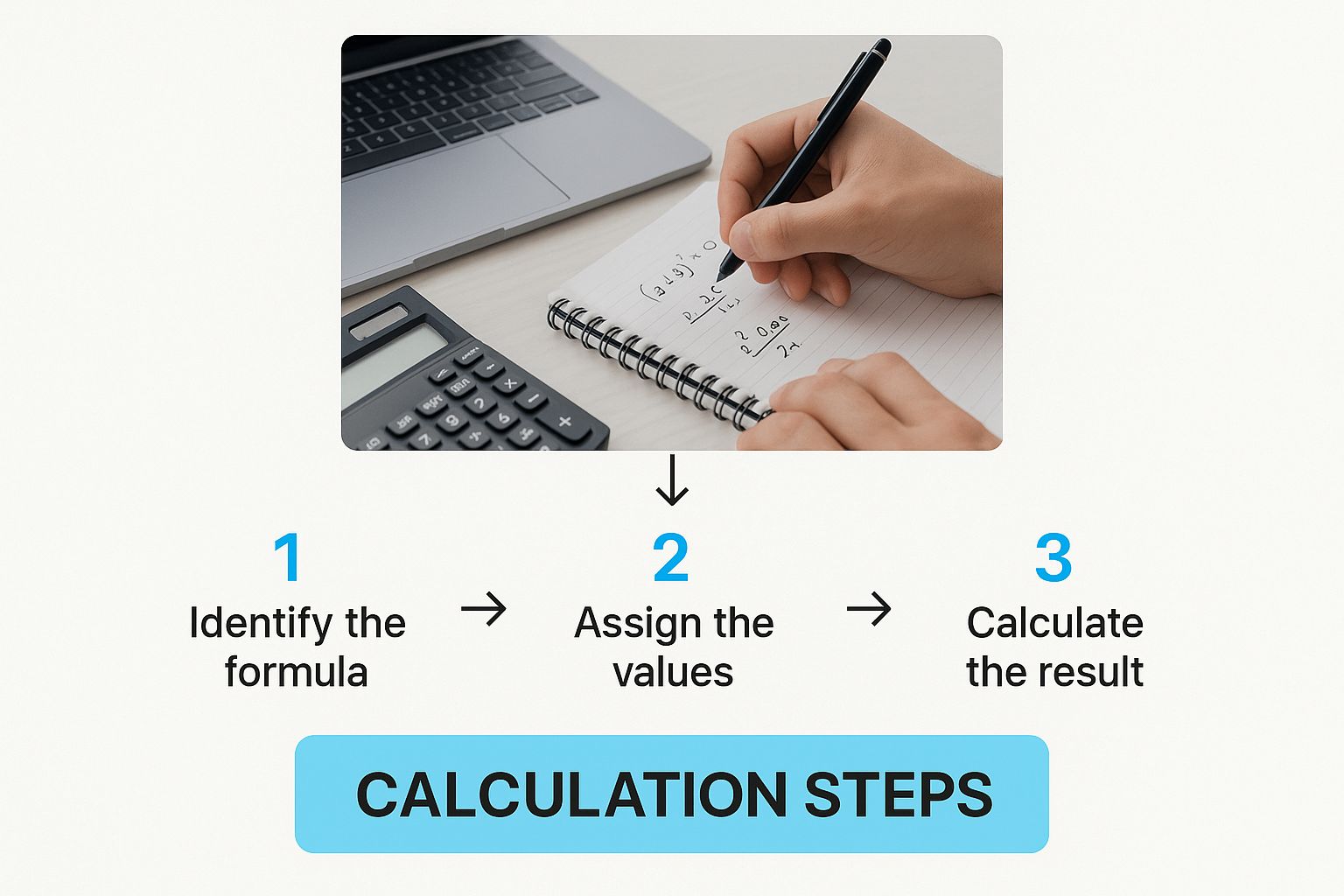




Calculating your risk-to-reward ratio is straightforward. You just divide the amount you stand to lose if you're wrong (the distance from your entry to your stop-loss) by the amount you stand to gain if you're right (the distance from your entry to your profit target).
A 1:3 ratio, for example, means you're putting $1 at risk for a potential $3 in profit. This simple piece of math is probably the most important tool you have for managing your money and making smart, disciplined decisions in the market.

Think of the risk-to-reward ratio as more than just a formula. It's a game plan that turns trading from a gamble into a calculated business. It makes you decide on your exit points—both for a loss and a win—before you ever click the "buy" button. This takes the emotion out of the picture when things get choppy.
This kind of pre-planning is the secret to staying in the game long-term. You're no longer just hoping a bad trade will turn around. Instead, you have a clear point where you know your idea was wrong (your stop-loss). On the flip side, you have a logical target to take profits based on what the chart is telling you, not just pure greed.
At its heart, the risk-to-reward ratio is about making sure your winning trades are big enough to more than cover your losing ones. You could have a high win rate and still bleed money if your few losses are huge compared to your many small wins.
This isn't a new concept. Look at the classic 60/40 portfolio (60% stocks, 40% bonds) in traditional investing. It's all about balancing higher-risk assets with safer ones to grind out stable returns. Historical data has shown this balanced strategy produced a U.S. Sharpe ratio of 0.32, which is just a fancy way of measuring the return you get for the risk you take. You can dig into the numbers in this deep dive on 60/40 portfolio performance.
The goal isn't to win every trade. The goal is to make sure your wins are mathematically more significant than your losses over time. The risk-to-reward ratio is the tool that makes this possible.
By consistently picking trades where the potential reward outweighs the risk, you start to build a real statistical edge. That's what professional trading is all about. It’s not about having a crystal ball; it's about managing probabilities so that even with a modest win rate, your account balance trends up.
To get a feel for how this plays out in the real world, here’s a quick guide to some common ratios you’ll see.
This table isn't about which ratio is "best"—it's about matching your ratio to your strategy and win rate. A scalper might thrive on a 1:1 ratio with a high win rate, while a trend follower could be very successful with a 1:5 ratio and only a 30% win rate. It's all about finding what works for you.
Alright, let's get down to brass tacks. Moving from theory to the trading floor is what separates the wannabes from the winners. To actually figure out your risk-to-reward ratio, you only need three numbers. Getting these right is the first step to trading with a plan instead of just a hunch.
The formula itself is beautifully straightforward:
Risk Reward Ratio = (Take-Profit Price - Entry Price) / (Entry Price - Stop-Loss Price)
At its core, this is just your potential profit divided by your potential loss. Simple as that.
Before you can even punch those numbers into a calculator, you have to know what they are. Each one is a critical decision you make before you put a single dollar on the line.
Once you have these three figures locked in, you have a complete picture of a trade's potential before you commit to it.
Keep this in mind: A great risk-to-reward ratio doesn't mean the trade is a guaranteed winner. What it does guarantee is that your winning trades will make you more money than your losing trades will cost you. That's how you grow an account over time.
Let’s say you’ve got your eye on a tech stock that’s currently sitting at $100 a share. You’ve done your homework, looked at the chart, and decided it’s time to go long.
Your analysis tells you there's a solid floor—a support level—at around $95. If the price drops below that, your entire trade idea is probably wrong. So, you set your stop-loss at $95. This caps your potential loss at $5 per share ($100 - $95).
Now, looking up, you see the next major ceiling—a resistance level—at $115. That looks like a great place to cash in, so you make it your take-profit target. Your potential reward is now $15 per share ($115 - $100).
With those numbers, the math is easy:
Ratio = $15 (Potential Reward) / $5 (Potential Risk) = 3
This works out to a 1:3 risk-to-reward ratio. For every single dollar you're putting on the line, you have the potential to make three back. That’s a trade worth considering.
The infographic below breaks down the basic flow of this calculation.

Seeing it visually really drives home the point: you have to know your exits before you even think about your entry. Of course, doing this by hand for every single trade can get old fast. To make life easier, you can use an automated risk reward ratio calculator to do the heavy lifting. Better yet, tools like EzAlgo can overlay this information directly onto your charts in TradingView, taking all the guesswork out of the equation.

Look at the chart above. A tool like EzAlgo automatically plots those crucial support and resistance levels for you. These are the exact building blocks you need to set your stop-loss and take-profit targets, making it much easier to calculate your risk-reward ratio with confidence.
The real beauty of this ratio is that it works everywhere. Whether you're in the fast-paced world of forex, the wild west of crypto, or the more traditional stock market, the core idea is always the same: make sure your potential winnings are worth the risk.
Of course, every market has its own personality. Crypto is notorious for its huge swings, which often means you need to set a wider stop-loss just to avoid getting knocked out of a perfectly good trade by a random price spike. On the other hand, a stable blue-chip stock might call for a much tighter stop based on more predictable price action.
Let’s walk through a classic forex setup. Imagine you're watching the EUR/USD pair and decide to go long at 1.0750, expecting it to climb.
Your chart analysis shows a solid support zone right below your entry. To protect yourself, you place a stop-loss at 1.0725. That sets your total risk at 25 pips.
Looking up, you see a clear resistance level at 1.0825—a logical spot for the price to hit a ceiling. You set this as your take-profit target, aiming for a 75 pip gain.
Do the math—75 divided by 25—and you get a clean 1:3 risk-reward ratio. For any currency trader, that's a textbook high-quality trade.
Now, let's jump over to a Bitcoin trade, where things get a lot more volatile. Say you buy in at $68,000. Bitcoin can move thousands of dollars in minutes, so you have to give your trade more breathing room.
You place your stop-loss at $66,000, which is a key psychological and technical floor. Your risk here is a full $2,000. Your analysis points to a major resistance cluster forming around $72,000, making it a great place to cash out. This puts your potential reward at $4,000.
This trade gives you a 1:2 risk-reward ratio ($4,000 potential reward / $2,000 risk). While it's not as high as the forex example, it's still a very solid ratio, especially in a market like crypto where a move like that can happen in a single day.
This kind of disciplined approach is what separates consistently profitable traders from the rest. Think about it like a big-picture portfolio. Analysis of the global 60/40 portfolio since 1997 shows that returns can swing wildly year-to-year, from +37% to –30%. But a consistent, balanced strategy smooths out those bumps over time. You can read more about how diversification impacts long-term returns on Vanguard.com.
Applying that same disciplined mindset to every single trade—by always demanding a favorable risk-reward ratio—is how you build a resilient and profitable trading strategy.
Knowing how to calculate your risk-to-reward ratio is a great start, but it's only half the story. I've seen countless traders learn the formula but still fall into the same old traps that slowly bleed their accounts dry.
Avoiding these common pitfalls is what really separates the consistently profitable traders from everyone else. Let's walk through the biggest mistakes so you can steer clear of them.
This one is huge. A trader finds a setup that looks just okay, but they desperately want it to work. So, they set an ambitious, almost fantasy-like profit target way up in the clouds, just to make the ratio look good on paper—maybe a 1:5 or 1:6.
This isn't trading; it's wishful thinking. You're forcing the numbers to fit your hopes, not the reality of the market. More often than not, these trades meander for a bit before reversing and smashing right through your stop-loss.
Here's a classic emotional blunder. You do everything right and enter a trade with a solid, pre-planned 1:3 ratio. But then, the price starts moving against you. Panic sets in.
You tell yourself the trade just needs "a little more room to breathe" and drag your stop-loss further down. In that single moment, you've thrown your entire plan out the window. Your carefully calculated risk is gone, and you're now exposing yourself to a much larger loss than you ever intended.
The same goes for greed on the other side. When a trade is going your way, it's tempting to move your take-profit target further out, hoping to squeeze every last drop from the move. This can turn a perfectly good winner into a loser when the market suddenly reverses.
A risk-to-reward ratio is a contract you make with yourself before you place the trade. Breaking that contract mid-trade means you're letting emotion, not logic, drive your decisions.
Sticking to your exit points is non-negotiable. For a deeper dive on this, our guide on how to properly set your take-profit and stop-loss levels will help you establish these crucial boundaries from the get-go.
I see traders get completely fixated on finding those unicorn trades with massive 1:5 or 1:10 ratios, thinking it's a golden ticket. But they're forgetting the other critical piece of the puzzle: win rate. A spectacular ratio means nothing if you almost never win.
Let's break it down with a simple comparison:
The goal isn't to find the biggest ratio possible. It's about finding a healthy balance between the ratios you target and your actual win rate. A great ratio doesn't make a trade a winner; it just ensures that when you do win, it's mathematically significant enough to more than cover your losses and keep you in the green.
Turning the risk-reward ratio from a theoretical concept into a fundamental part of your trading strategy is what really separates the pros from the hobbyists. It’s about building a system that can last, rather than just chasing one-off wins. The best place to start is by setting a firm, non-negotiable minimum ratio for any trade you even consider taking.
Make a simple rule for yourself: you will not touch any trade offering less than a 1:2 risk-to-reward ratio. This one decision acts as a powerful filter. It automatically weeds out low-probability setups and emotionally charged trades, forcing you to hunt for opportunities where the potential profit genuinely outweighs the risk. It’s a fantastic way to bake discipline right into your trading process.
Your ideal ratio isn’t one-size-fits-all; it should feel natural for how you trade. A scalper or day trader, who is in and out of the market quickly, might do great with a consistent 1:2 ratio, grabbing smaller, frequent profits.
On the other hand, a swing trader holding positions for days or weeks will probably want something more substantial, like a 1:3 or even 1:4 ratio, to justify tying up capital for that long.
The secret ingredient here is consistency. Once you find a ratio that fits your style, apply it to every single trade. This takes the emotional guesswork out of the equation.
The biggest win here is psychological. When you have predefined rules for your entry, stop-loss, and take-profit, the stress of making a split-second decision just melts away. You're no longer gambling—you're executing a thought-out plan with a statistical edge.
This discipline is what creates long-term stability in your account. A fascinating study on the global market portfolio from 1970–2022 showed that its risk-adjusted performance was far more stable and had smaller drawdowns compared to just holding equities. If you're interested in the data, you can read the full findings on risk-adjusted performance here.
At the end of the day, managing your downside is just as critical as chasing big returns. Consistently applying a solid risk-reward framework isn't just a good habit—it’s the superpower you need to build a truly resilient trading account.
If you're just getting into day trading, a solid benchmark to aim for is a 1:2 risk-to-reward ratio. Put simply, this means for every dollar you're willing to lose, you're aiming to make two.
This simple rule is powerful because it means you don't have to win every single trade to be profitable. In fact, with a 1:2 ratio, you can be right less than half the time and still come out ahead.
But here's a crucial piece of advice: don't get hypnotized by massive ratios. A 1:10 ratio looks incredible on paper, but it's completely worthless if your profit target is so far out that the price never actually reaches it. Your stop-loss and take-profit levels need to be grounded in reality, based on actual market structure like support and resistance zones, not just wishful thinking.
Tired of manually drawing lines and second-guessing your entry points? EzAlgo gives you a data-driven edge by automatically plotting key levels and providing clear signals. This takes the guesswork out of calculating your risk-to-reward, letting you trade with more confidence.
See exactly how it works at EzAlgo.ai.